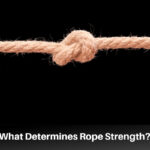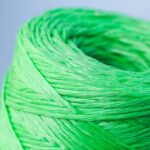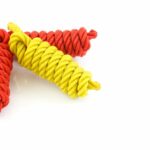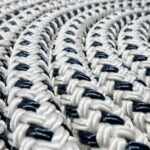Natural and synthetic types of rope are helpful for crafting and decoration, outdoor activities, tying down boats and equipment, and bearing massive loads.
Rope comprises natural or synthetic fibers or filaments. The fibers and filaments are woven to create strong rope cords. The Merriam-Webster Dictionary defines a rope as “a large stout cord of strands of fibers or wire twisted or braided together.”
Natural ropes consist of fibers like jute, cotton, coir, sisal, manila, and hemp. These ropes are better suited for light to moderately-harsh use. They are suitable for things like crafting, decoration, garden, or farm use.
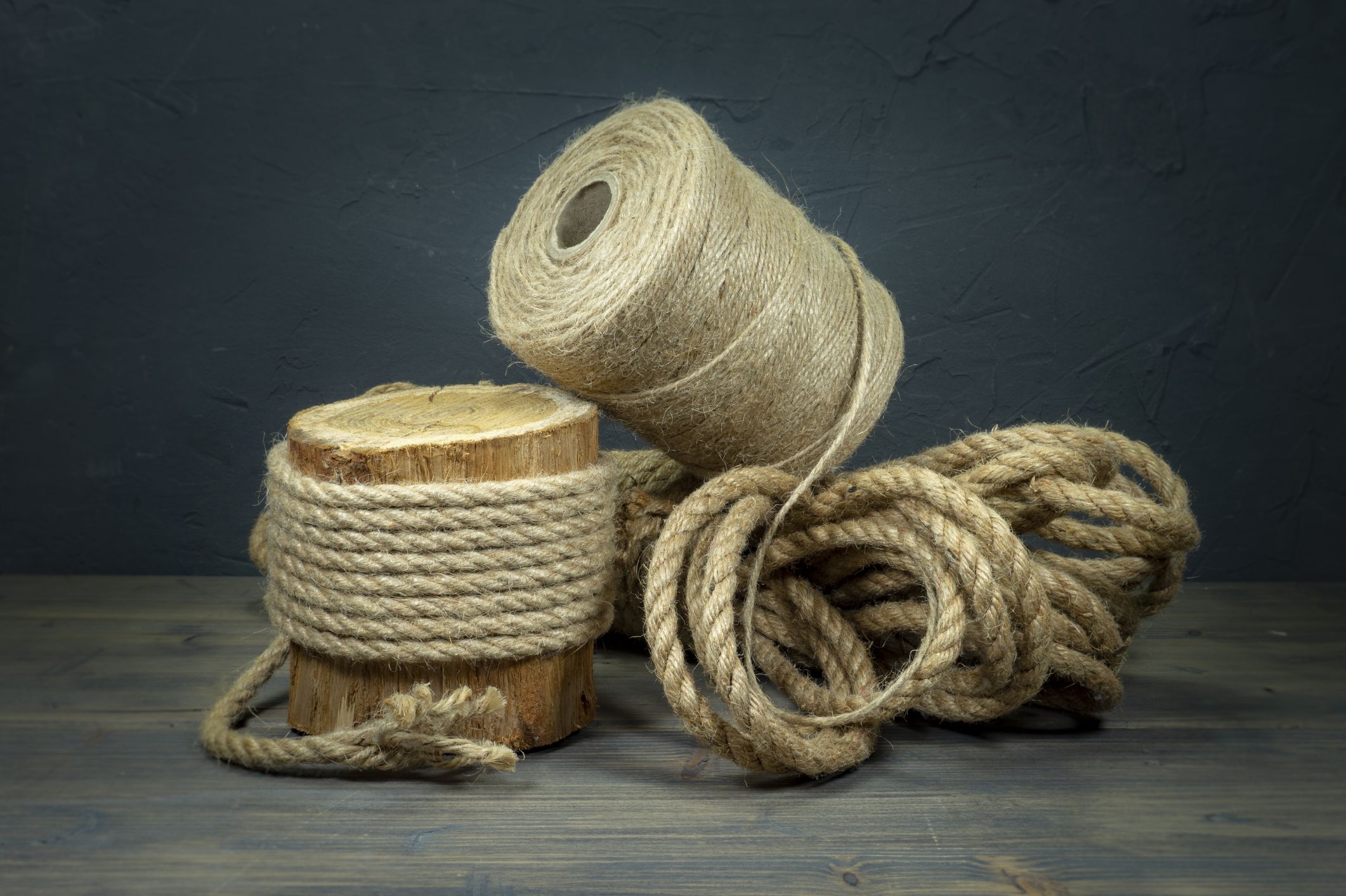
Synthetic ropes comprise fibers like steel, polypropylene, nylon, polyester, and polyethylene. These synthetic ropes are stronger and more durable than most natural fiber ropes. So, we can use them in harsher conditions.
Wire ropes are mostly made of steel. They withstand heavier loads and more pressure than other synthetic and natural ropes. Wire ropes comprise a core, wires, and strands. The materials come from bright, stainless, or galvanized steel. For added protection and durability, wire ropes receive a coating. The coating comprises PVC, polypropylene, nylon, polyester, or polyethylene.
The woven patterns are just as crucial for the strength and flexibility of the ropes. Braided and plaited ropes are more robust than twisted or hollow ropes. Some rope patterns are specific to their use. For instance, the sheath-and-core rope is explicitly designed for rope climbing.
What Is the Difference Between Natural & Synthetic Ropes?
The main difference between natural and synthetic ropes is the material of the rope. Natural ropes come from the fibers or filaments of crops and grasses. Synthetic materials are artificial.
The Complete Guide To Knots And Knot Tying by Geoffrey Budworth explains the difference between natural and synthetic ropes in greater detail:
“Vegetable fibers are short and must be spun and twisted to create the long yarns and strands needed for rope. It is the countless fiber ends that give traditional ropes their characteristic hairy appearance and useful surface grip. Long synthetic filaments run the full length of the ropes they form, so manmade cordage is smooth — unless the filaments are purposely chopped into shorter lengths of staple fibres to make ropes that recapture the desirable handling qualities of the older natural cordage.”
What Are The Natural Types Of Rope?
Natural rope comprises plant fibers like jute, cotton, coir, sisal, manila, and hemp. They do better in high-heat environments but don’t do well in wet conditions because they mold and rot quickly.
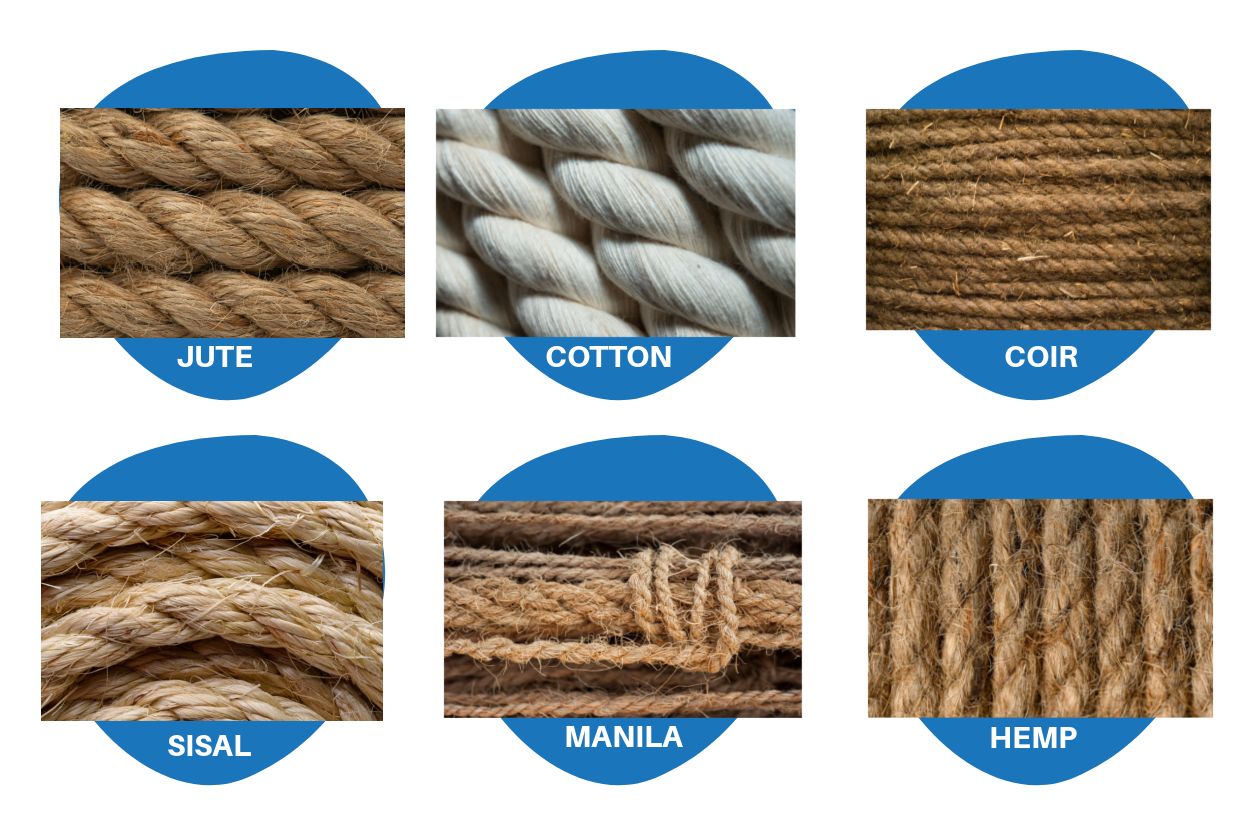
Jute
Jute rope comes from the fibers of the jute plant. Most people use it in crafts and gift wrapping because of its soft and shiny material.
Cotton
Cotton is the softest rope, making it comfortable to work with. Its stretchiness and lightweight texture make it ideal for decorative purposes like macrame. Due to its light coloration, you can dye it. Besides crafts, people use cotton rope for clotheslines, cords for Venetian blinds, magic tricks, and pet toys.
Coir
Coir is coconut fiber. It comes from the material between the hard inner shell and the outer shell of the coconut. Coir absorbs water and salt without the quality becoming damaged or less durable. It is helpful for aquatic farming and uses in gardens. The durability also makes it popular for fencing, hanging bird feeders or clotheslines, and creating woven floor mats.
Sisal — The Most Durable Natural Fiber Rope
Sisal rope comes from the sisal hemp (agava sisalana) plant. Sisal is the most durable natural fiber rope. It is more resistant to rot, mold, UV light, and breaking down in the water. Manila rope holds more weight but is less durable.
Popular uses for sisal rope include decoration, crafting, rugs, fishing nets, and climbing ropes in gyms.
Manila
Manila rope gets its name because it used to come from manila hemp fibers. Today, manila ropes come from the abaca plant.
Manila is stronger than the other natural ropes. It is resistant to moisture, rot, sunlight, and abrasion. The rope is also flexible, making it easy to tie into knots. The downside is that manila shrinks when wet, so knots are likely to be permanent.
Manila is resistant to rot, so most people use it in marine or outdoor settings. In ancient times, manila ropes were great for fishing nets. Besides marine uses, we use manila for timber or garden decking, construction, agriculture, stair ropes, and ornamental purposes.
Hemp
Hemp rope comes from the fibers of the hemp plant and is one of the most durable kinds of natural ropes. Hemp is a good option because it is resistant to mold, mildew, and UV rays. Popular uses of hemp rope include tying down cargo, securing ships, and creating pet toys.
What Are Synthetic Ropes?
Synthetic ropes come from artificial materials like wire, polypropylene, nylon, polyester, and polyethylene. No matter the material, synthetic ropes tend to be stronger than natural ropes. Wire ropes are seen more in industrial usage because of their capability to hold burdensome weight and withstand extreme conditions.
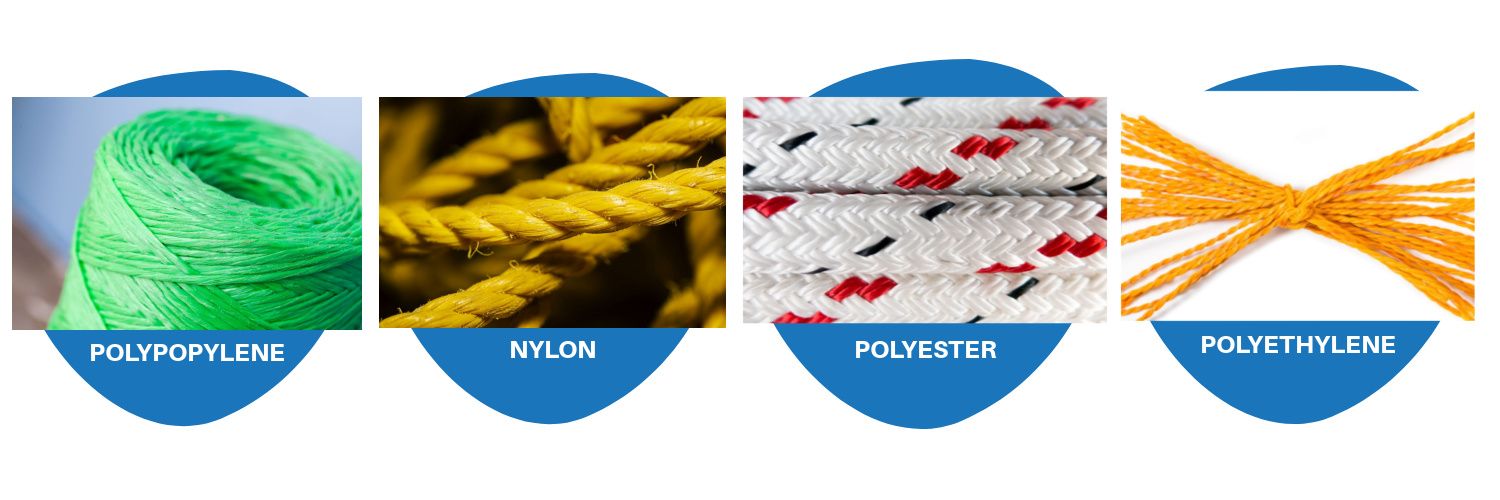
Polypropylene
Polypropylene is the best rope to use in wet environments and is most commonly used to create swimming pool lanes.
Polypropylene is lightweight and doesn’t absorb water, so it can float on the water’s surface. It is also resistant to chemicals, oil, mold, and mildew, making it perfect for nautical and other wet settings.
These ropes are versatile; you can buy them braided, twisted, or hollow.
Polypropylene is an excellent choice for horse tack and dog leads because they are resistant to chemicals and moisture.
Nylon — The Best Rope For Tie-Downs
Nylon ropes are the strongest synthetic ropes for everyday use. The material is strong enough to hold extreme loads but is also flexible and returns to its original shape after being stretched. They are also excellent at absorbing shock.
Nylon is resistant to chemicals, mold, mildew, and abrasion, so they are a good choice for outdoor, industrial, and gym settings.
These ropes are versatile and are available as braided, plaited, or twisted, although braided ropes can hold the most weight.
Polyester — The Best All-Purpose Rope
Polyester ropes are similar in strength to nylon ropes, but they barely stretch, so they don’t absorb shocks well. Polyester is flexible and soft and does not lose strength when wet. Like nylon, polyester is resistant to chemicals, moisture, abrasion, and sunlight.
Polyester is great for use as a garden rope and is one of the most popular ropes in the boating industry. People commonly use polyester rope for anchors and mooring lines, lanyards, and fishing nets.
Polyethylene
Polyethylene rope is famous for its wavy texture that makes for easy gripping. It is ideal for wet areas like pools and fishing areas because it’s waterproof, lightweight, and cold-tolerant. Polyethylene is also cheaper than other similar options. These ropes aren’t ideal for extreme situations but are suitable for recreational activities where the weight load is light.
Dyneema is the strongest rope material: 15 times stronger than steel. It is an ultra-high molecular weight polyethylene fiber that is the strongest but lightest rope fiber.
While Dyneema is 15 times stronger than steel, it is also eight times lighter. It doesn’t absorb water, so it remains lightweight even in contact with water. Dyneema is also chemical and UV light resistant.
What Are Synthetic Rope Coverings?
Wire ropes need coverings for added protection, strength, and flexibility. The coatings offer protection against corrosion, the sun, chemicals, and abrasions. Rope coverings come in the same materials as synthetic ropes: polypropylene, nylon, polyester, and polyethylene. Coatings are also available in PVC.
PVC
PVC is a standard rope coating because it’s flexible, cheap, and ideal for general use. PVC material is a hard material that’s difficult to break, and it works in temperatures well in extreme temperatures.
What Are Wire Ropes?
Wire ropes comprise three parts: the wire, strand, and core, which all wind together to create the rope.
Wire ropes handle extreme weights. They lift loads far greater than natural ropes can take. Unlike natural ropes, the outer strands of wire ropes move in a uniform pattern that supports the rope’s core.
What Is The Core?
The core of the wire rope forms the center of the rope and comprises synthetic or natural fibers. The core is either a single wire or forms from another wire rope. The core is the most crucial part of the wire rope because it supports the entire structure.
Fiber Cores
We only use fiber-based cores for lighter loads in normal conditions because they’re weak. They are not suitable for harsh conditions, but nylon and polypropylene do well with chemical exposure.
Wire Cores
Wire cores comprise an entire wire rope acting as the core. Additional wire ropes are layered on top of the initial core wire rope. Wire cores are best suited for harsher conditions where the rope experiences exceptional resistance and heavy loads.
Strand Core
A strand core comprises wire strands the same length and diameter as the rest of the strands that make up the rope.
What Is The Wire?
The wire comprises a type of metal, like steel, stainless steel, galvanized steel, aluminum, nickel alloy, bronze, copper, or titanium. Manufacturers choose the type of metal depending on the kind of work the rope will do because different materials have various strengths, flexibility, and abrasion resistance capabilities.
Bright Steel
Bright steel is the most common type of wire rope used for manufacturing, construction, and industrial purposes. It doesn’t have a coating but is resistant to rotation. You can buy steel ropes in a variety of sizes and strengths.
Stainless Steel
Stainless steel is weaker than bright and galvanized steel. It is resistant to corrosion, rust, wear, and stains, so it is ideal for use in harsh environments. Despite being weaker than the others, it lasts longer and is more expensive.
Galvanized Steel
Galvanized steel is cheaper than stainless steel and is coated in zinc to protect against corrosion. It is just as strong as bright steel but only does well in normal to mildly-harsh conditions.
The Strand
A strand refers to the way wires are wrapped together to create a pattern. Wire ropes have a core which usually comprises a single wire, and the rest of the wires wrap around the core wire to create a bundle. Then, multiple bundles wrap together to create the rope.
Most ropes consist of seven wires, with one wire acting as the core and the other six wrapping around the core. The number of wires that wrap around the core determines the rope’s overall size, strength, and flexibility.
Single Layer
A single-layer strand has one wire at the core with several wires wrapping around the core.
Multiple Layer
Single wires are placed on top of each other in a multiple-layer strand to form smooth and even layers.
Seale
In a seale pattern, small wires wrap around a large core wire. In the next layer, larger wires wrap around the layer of small wires.
Warrington
The Warrington pattern is like the multiple-layer pattern, but the outer layer is different. The inner wires and the core continue to have the same diameter, and the outer layer comprises alternating small and large wires.
Filler
Wires in a filler pattern are all the same size and shape, but smaller wires sit in the spaces between the main wires.
Flattened
A flattened wire comprises three same-sized wires at the core. Around the core, another layer of wires creates a triangular pattern. The triangular shape formed by this pattern makes a stronger rope.
Centerless
Centerless strands don’t have a core. Instead, all the wires are the same diameter and length and wind together in a spiral pattern.
Rope Designs
The materials a rope is made of determine its strengths, but so does the rope’s design. You can fashion ropes in many ways, and specific designs are better for various scenarios.
Plaited Ropes
Plaited ropes look like braided ropes because they are both made by weaving strands together. Plaited ropes are different from braided ropes because a single strand weaves over two other strands, similar to how we construct hair braids.
Plaited ropes rarely kink, and they’re soft and flexible, so they’re the best rope for outdoor use, like camping.
Single Braided Ropes
Single-braid ropes consist of synthetic materials. People make them by wrapping 8-12 strands of fiber around a solid core. Half of the strands twist clockwise, while the other half twists counterclockwise. Both clockwise and counterclockwise twisting coincides, so the fibers weave in and out of one another.
Single braids are some of the best ropes for sailing because they’re strong but flexible and don’t kink easily. They’re also softer than most ropes, so they’re ideal for people who work their sails by hand.
Besides sailing, single-braided knots are suitable for camping and other outdoor scenarios.
Double Braided Ropes
A double-braided rope is simply two single-braided ropes wrapped around each other. The first single-braided rope lays straight and makes up the core. The second single-braided rope wraps around the first. Combining the two ropes makes the rope twice as strong but as flexible as a single-braided rope.
“Laid” Or Twisted Ropes
Twisted ropes are the most common type and usually consist of natural materials. It is a simple design where two to three strands wrap around each other to form a twist.
Twisted ropes are great for use in the gym and rock climbing because they are easy to grip. They are also popular in creating decorative crafts.
Though twisted ropes are strong, they are prone to fraying. Their texture is not very smooth, so they will likely get caught on things if you use them to pull.
Sheath-And-Core Ropes
Sheath-and-core ropes are explicitly used for climbing. These ropes have a static component that bears the total weight of the climber and can withstand significant wear and tear from regular climbing. Dynamic ropes are unloaded but have more elasticity and strength for the climber’s safety.
Hollow Ropes
Hollow ropes may come braided or plaited, but they are characterized by having a hollow center. They are most commonly used for nautical purposes because they are weatherproof ropes and are less likely to trap water, keeping them lightweight.
The downside of having a hollow center is that the ropes are much weather than traditional braided or plaited ropes.
FAQs
Where To Buy Rope Near Me
Rope is a popular product that you can purchase at nearly any hardware store. Home Depot, Lowes, Walmart, and Tractor Supply all keep various ropes in stock. You can also buy your rope online from places like Amazon or knotandrope.com.
Does Polypropylene Rope Float?
Polypropylene is a lightweight material that doesn’t absorb water and floats. It is one of the best materials to use in swimming pools and marine applications because of its resistance to water and mold.
